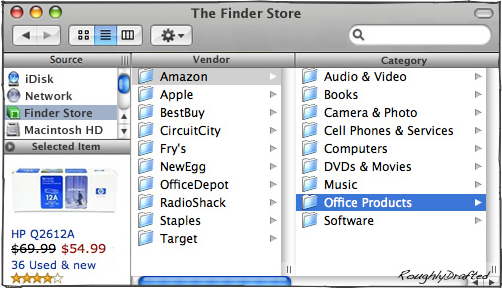

Apple's nebulous .Mac services were introduced in What the Heck is .Mac? In 10 Reasons Why Apple Can Kickstart Web 2.0 I presented why Apple is uniquely poised to actually deliver .Mac services well worth the price of admission. In this series, I'll describe features I think Apple needs to add to their .Mac service to move it from "web hosting and email plus" to a complete suite of services that are valuable, obvious, and will sell themselves to potential .Mac subscribers. Plus, I want to use them!
Halfway to a Perfect .Mac
So far, I've described a new future for .Mac as an an online community of (1) hyperbloged discussion, review and sharing, where members (2) earn reputation in a (3) connected social network with (4) real identity and security features. The combined effect of all these features works like iLife, where each individual part is good, but there is even more value in using the collection as whole.
So far, I've described a new future for .Mac as an an online community of (1) hyperbloged discussion, review and sharing, where members (2) earn reputation in a (3) connected social network with (4) real identity and security features. The combined effect of all these features works like iLife, where each individual part is good, but there is even more value in using the collection as whole.

In .Mac, the integration of these features enables things like:
-
•distilling and highlighting useful bits of information and discussion on the web;
-
•cleaning up and killing off annoyances like spam, sybils, spoofing, phishing, and other fraud;
-
•collecting a smart population interested in fun, useful, and productive things; and
-
•creating a safe and secure refuge from the dysfunctional chaos of the Internet.
Basically, Apple is in the position to create an Internet territory under the rule of law. That's something few other entities could accomplish. Who would want to visit or live in a virtual world owned by, say, Microsoft? What sort of structure could a distributed open source community, which inherently dislikes the general idea of central authority, create for users?
Apple already has a tight community that polices itself. The main reason why Mac users aren't plagued with spyware and viruses isn't the limited size of the Mac community, but rather the tight nature of the community itself. When users discover sketchy software, they talk about it online among the many venues like MacInTouch, and the problem software is either reformed or ostracized. The impending growth of the Mac world won't change that at all.
 In the Mac's early days, this same community effect was the force behind weeding out "non-Mac like" software that diverged from Apple's Human Interface Guidelines. Developers found that if they didn't follow the rules in building Mac software, Mac users simply wouldn't buy it. Outside in the PC world, there was no similar force in place to align interface features cohesively, so developers just did whatever they felt like, and PC software ended up with an ugly, inconsistent and often bizarre interface.
In the Mac's early days, this same community effect was the force behind weeding out "non-Mac like" software that diverged from Apple's Human Interface Guidelines. Developers found that if they didn't follow the rules in building Mac software, Mac users simply wouldn't buy it. Outside in the PC world, there was no similar force in place to align interface features cohesively, so developers just did whatever they felt like, and PC software ended up with an ugly, inconsistent and often bizarre interface. Today, the same lack of community outside of the Mac world fosters a wild west atmosphere where anything goes: anonymous or spoofed spam, phishing and hate mail; exploitive spamvertising using viruses, worms, spyware, and adware; and deceptive and fraudulent marketing that pushes vaporware, malware and other junk products.
In the real world, citizens look to a government to provide a foundation of stability, to enable security and enforce the rule of law. On the Internet, people have good reason to fear the involvement of government, or the central control of any single authority. Apple's unique position in the industry enables it to offer such stability and security online in a way that is wholly voluntary and optional, so it poses no threat to the rest of the web.
In fact, this principle is already in place in the iTunes Music Store. Apple has created a system where downloads just work, the commerce behind it is secured, the rights of users are respected, and the predatory tactics of scammers is prohibited. My next idea for .Mac expands upon that:
Borrows Ideas From:
Apple can build upon existing services because Apple has (1) the users, and (2) owns the platforms to roll it out. The system is (3) given away for free, as part of .Mac. Apple knows how to run business both (4) online and (5) face to face, and users (6) trust Apple with their purchases. Further, Apple has proven they can build things that (7) work, are (8) usable, (9) very cool, and (10) will actually get finished.
Here's how it works:
Apple already handles millions of small and frequent payments in the iTMS, one of the biggest micropayment systems on the web. Apple needs to extend those payment services to .Mac members, allowing them to transact securely, accept credit card payments, create gift certificates, register wishlists, or accept donations. Further, they need to extend idea behind the iTMS to include:
-
•third party software, enabling small developers to sell software downloads and securely distribute updates;
-
•hardware and accessory vendors;


-
•vendors offering related services; and
-
•classified ads from .Mac members.
I described an .Mac community store in a Leopard Wishlist article, which would help users find products and services. For example, it would recommend and order the correct replacement ink for a user's printer, or help them find the right part numbers to order a RAM upgrade. I suggested integrating such a store into the Finder. Apple is almost there, they just need to take the extra half step.
Create Specialized Groups: .Mac Businesses
Apple seems to have designed .Mac Groups with soccer teams in mind, but it's a minor jump to create a .Mac Group that's actually a virtual storefront.
Being part of .Mac means that the store could enjoy verified identity and earn reputation (like Ebay), while also benefitting from micropayment transactions (like iTMS or PayPal) and other business services, such as listings in a .Mac business directory (like the Yellow Pages).
Apple already runs a directory of Mac products; they just need to translate that into .Mac Business Groups, with an iTunes inspired listing of the product and services in the new Finder Store. Users could rate, comment, and of course, buy their wares (like Amazon).
 Merchants would join .Mac to participate, and register and mange their product and service portfolio just like music labels and broadcasters manage their content for sale in the iTMS. Individuals with .Mac accounts could list items for sale in the Finder Store’s classified ads (like Craigslist), just as iLife users can now upload their Podcasts into iTMS.
Merchants would join .Mac to participate, and register and mange their product and service portfolio just like music labels and broadcasters manage their content for sale in the iTMS. Individuals with .Mac accounts could list items for sale in the Finder Store’s classified ads (like Craigslist), just as iLife users can now upload their Podcasts into iTMS.To broaden its appeal and market reach, the Finder Store would be available to anyone, not just .Mac members. Further, the Finder Store wouldn't just be a place to buy things. Users could also subscribe to software update subscriptions (a podcast of updates), which would notify them automatically (like VersionTracker) when developers release new versions and updates of their products in the Finder Store.
Remember when magazines had mail in reader information cards? Filling in a number to get information from a vendor was a bit scary, because there was no way to turn off the faucet of advertising later. In the .Mac world, users could lookup businesses and subscribe to their product update email lists, and then manage those subscriptions centrally.
That would benefit both vendors and customers, because potential buyers would be less wary of signing up for news, knowing they have the option to turn it off when they are no longer interested.
Like iTMS, the Finder Store would make it:
-
•easy to search for products,
-
•easy to leave comments and ratings,
-
•easy to create wishlists and product recommendations,
-
•easy to place one-click orders and give gift certificates and allowances, and
-
•easy to review previously ordered items, even when offline.
Bang! Apple could easily translate the digital media success of the iTMS into a general purpose Finder Store, creating a safe, secure marketplace for Mac users, and enabling a range of new valuable services for their .Mac subscribers.
But wait there's more.

| | Comment Preview
 Read more about:
Read more about:

 Send |
Send |

 Subscribe |
Subscribe |
 Del.icio.us |
Del.icio.us |
 Digg |
Digg |
 Furl |
Furl |
 Reddit |
Reddit |
 Technorati
Technorati
Click one of the links above to display related articles on this page.
Fixing .Mac - Idea 5: A .Mac Marketplace
Friday, June 23, 2006
















